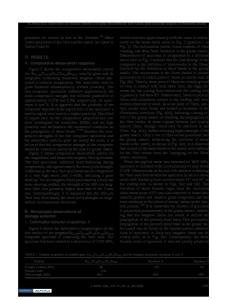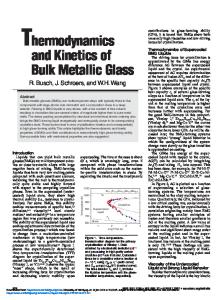Effect of frame stiffness on the deformation behavior of bulk metallic glass
- PDF / 1,327,666 Bytes
- 5 Pages / 584.957 x 782.986 pts Page_size
- 79 Downloads / 364 Views
H.J. Gaob) Division of Engineering, Brown University, Providence, Rhode Island 02912 (Received 9 March 2010; accepted 18 May 2010)
It has been shown that the stability of shear banding and plasticity of bulk metallic glasses (BMGs) can be strongly influenced by the machine stiffness. Here, we demonstrated that the practice of adding a frame parallel to the sample is quantitatively equivalent to increasing the machine stiffness by the frame stiffness. A series of carefully designed experiments were conducted to verify such an effect, showing controllably enhanced plasticity of BMG samples.
I. INTRODUCTION
The plastic deformation of metallic glasses is known to be concentrated in shear bands. Because of this unique characteristic and the fact that the stability of shear banding is controlled by the elastic energy stored in the sample and in the testing machine, it has been shown that the apparent mechanical behavior of metallic glasses is governed by both the sample size and the machine stiffness.1–4 Specifically, increasing the machine stiffness lowers the amount of elastic energy stored in the machine, thereby retarding shear band instability and enhancing plasticity in these materials. The importance of frame stiffness on the deformation behavior of metallic glass was recognized by as far back as Murata et al.2 who designed a tensile testing frame made of stainless steel [schematically shown in Fig. 1(a)]. The tensile extension of the sample is realized through thermal expansion of the exterior steel frame. They estimated that the elastic energy stored in the frame is only one-third of the energy for fracture of the sample. With this device providing high stiffness, they reported tensile elongation and successful stoppage of the catastrophic fracture of the metallic glass under test. Although the interaction among machine, frame, and sample is already qualitatively understood, no theoretical explanation for the effect of frame stiffness on the improved apparent ductility of the metallic glass was provided by Murata et al.2 Although these authors claimed that the framelike device is equivalent to a hard type of machine, it should Address all correspondence to these authors. a) e-mail: [email protected] b) e-mail: [email protected] DOI: 10.1557/JMR.2010.0256 1958
http://journals.cambridge.org
J. Mater. Res., Vol. 25, No. 10, Oct 2010 Downloaded: 14 Mar 2015
be noted that this kind of configuration of increasing the “machine stiffness” by using an exterior frame parallel to the sample seems fundamentally different from that in Ref. 1, where a machine of increasing stiffness is connected to the sample in series. In other words, the connection between the frame, which is parallel to the sample, and the machine, which is serial to the sample, is not intuitive and has not been rigorously established. Here, we show that adding a frame parallel to the sample is quantitatively equivalent to increasing the machine stiffness by the frame stiffness. We will first provide a theoretical analysis on such a configuration
Data Loading...











